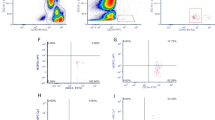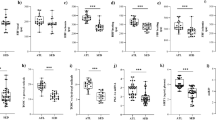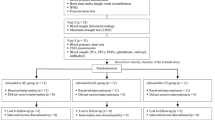Abstract
Exercise has been proved to promote the number and activity of circulating endothelial progenitor cells (EPCs) in humans, which contributes to improvement in endothelial function and maintenance of cardiovascular homoeostasis. However, the mechanism underlying the effect of exercise on circulating EPCs in healthy subjects is not completely understood. Here, we investigated whether the regulation of acute exercise on circulating EPCs is associated with nitric oxide (NO), vascular endothelial growth factors (VEGF) and granulocyte macrophage colony stimulating factor (GM-CSF) known to modulate circulating EPCs in healthy subjects. A total of 16 healthy male volunteers underwent a modified Bruce treadmill acute exercise protocol. The number and activity of circulating EPCs, as well as the levels of NO-VEGF and GM-CSF in plasma and culture medium before and after exercise in healthy subjects were measured. The number and activity of circulating EPCs after acute exercise were significantly higher than those before exercise in healthy subjects. In parallel, acute exercise significantly enhanced plasma NO level in healthy subjects. There is a significant linear regression relationship between the enhanced plasma NO level and increased number or activity of circulating EPCs. However, no change of plasma VEGF and GM-CSF level was observed after acute exercise. The secretion of NO-VEGF and GM-CSF by cultured EPCs remained unchanged in response to acute exercise. The present study demonstrates for the first time that acute exercise-induced NO production contributes to upregulation of circulating EPCs in healthy subjects, which suggests that NO plays an important role in the regulation of exercise on circulating EPCs.
This is a preview of subscription content, access via your institution
Access options
Subscribe to this journal
Receive 12 digital issues and online access to articles
$119.00 per year
only $9.92 per issue
Buy this article
- Purchase on Springer Link
- Instant access to full article PDF
Prices may be subject to local taxes which are calculated during checkout





Similar content being viewed by others
References
Verma S, Buchanan MR, Anderson TJ . Endothelial function testing as a biomarker of vascular disease. Circulation 2003; 108: 2054–2059.
Tao J, Jin YF, Yang Z, Wang LC, Gao XR, Liu L et al. Reduced arterial elasticity is associated with endothelial dysfunction in persons of advancing age: comparative study of noninvasive pulse wave analysis and laser Doppler blood flow measurement. Am J Hypertens 2004; 17: 654–659.
Hill JM, Zalos G, Halcox JP, Schenke WH, Waclawiw MA, Quyyumi AA . Circulating endothelial progenitor cells, vascular function, and cardiovascular risk. N Engl J Med 2003; 348: 593–600.
Tao J, Wang Y, Yang Z, Tu C, Xu MG, Wang JM . Circulating endothelial progenitor cell deficiency contributes to impaired arterial elasticity in persons of advancing age. J Hum Hypertens 2006; 20: 490–495.
Heiss C, Keymel S, Niesler U, Ziemann J, Kelm M, Kalka C . Impaired progenitor cell activity in age-related endothelial dysfunction. J Am Coll Cardiol 2005; 45: 1441–1448.
Werner N, Nickenig G . Influence of cardiovascular risk factors on endothelial progenitor cells: limitations for therapy? Arter Thromb Vasc Biol 2006; 26: 257–266.
Vasa M, Fichtlscherer S, Aicher A, Adler K, Urbich C, Martin H et al. Number and migratory activity of circulating endothelial progenitor cells inversely correlate with risk factors for coronary artery disease. Circ Res 2001; 89: e1–e7.
Schmidt-Lucke C, Rössig L, Fichtlscherer S, Vasa M, Britten M, Kämper U et al. Reduced number of circulating endothelial progenitor cells predicts future cardiovascular events: proof of concept for the clinical importance of endogenous vascular repair. Circulation 2005; 111: 2981–2987.
Alexandra A, Andreas MZ, Stefanie D . Mobilizing endothelial progenitor cells. Hypertension 2005; 45: 321.
Daniel JG, Andrew M, Gerry OD, Roger T . Effect of exercise training on endothelium-derived nitrix oxide function in humans. J Physiol 2004; 561: 1–25.
Vita JA, Keaney JF . Exercise: toning up the endothelium. N Engl J Med 2000; 342: 503–504.
Hambrecht R, Wolf A, Gielen S . Effect of exercise on coronary endothelial function in patients with coronary artery disease. N Engl J Med 2000; 342: 454–460.
Sabine S, Alexander N, Sophie Z, Bernhard R, Daniela S, Johannes P et al. Endurance training increases the number of endothelial progenitor cells in patients with cardiovascular risk and coronary artery disease. Atherosclerosis 2005; 181: 305–310.
Ulrich L, Nikos W, Andreas L, Matthias E, Wassmann KJ, Eckart M et al. Physical training increases endothelial progenitor cells, inhibits neointima formation, and enhances angiogenesis. Circulation 2004; 109: 220–226.
Croce G, Passacquale G, Necozione S, Ferri C, Desideri G . Nonpharmacological treatment of hypercholesterolemia increases circulating endothelial progenitor cell population in adults. Arter Thromb Vasc Biol 2006; 26: e38–e39.
Sandri MB, Adams V, Gielen S, Linke A, Lenk K, Kränkel N et al. Effects of exercise and ischemia on mobilization and functional activation of blood-derived progenitor cells in patients with ischemic syndromes: results of 3 randomized studies. Circulation 2005; 111: 3391–3399.
Volker A, Karsten L, Axel L, Dominik L, Sandra E, Markus S et al. Increase of circulating endothelial progenitor cells in patients with coronary artery disease after exercise-induced ischemia. Arter Thromb Vasc Biol 2004; 24: 670–684.
Jalees R, Jingling LM, Lakshmi P, Gudjon K, Vipul RP, Constance JT et al. Exercise acutely increases circulating endothelial progenitor cells and monocyte-/macrophage-derived angiogenic cells. J Am Coll Cardiol 2004; 43: 2314–2318.
Laufs U, Urhausen A, Werner N, Scharhag J, Heitz A, Kissner G et al. Running exercise of different duration and intensity: effect on endothelial progenitor cells in healthy subjects. Eur J Cardiovasc Prev Rehabil 2005; 12: 407–414.
Duda DG, Fukumura D, Rakesh KJ . Role of eNOS in neovascularization: NO for endothelial progenitor cells. Trends Mol Med 2004; 10: 143–145.
Alexandra A, Christopher H, Dimmeler S . The role of NOS3 in stem cell mobilization. Trends Mol Med 2004; 10: 421–425.
Asahara T, Takahashi T, Masuda H, Kalka C, Chen D, Iwaguro H et al. VEGF contributes to postnatal neovascularization by mobilizing bone marrow-derived endothelial progenitor cells. EMBO J 1999; 18: 3964–3972.
Powell TM, Paul JD, Hill JM, Thompson M, Benjamin M, Rodrigo M et al. Granulocyte colony stimulating factor mobilizes functional endothelial progenitor cells in patients with coronary artery disease. Arter Thromb Vasc Biol 2005; 25: 1–6.
Gerald FF, Balady GJ, Amsterdam EA, Bernard C, Robert E, Jerome F et al. Exercise standards for testing and training – a statement for healthcare professionals from the American Heart Association. Circulation 2001; 104: 1694–1740.
Yang Z, Tao J, Wang JM, Tu C, Xu MG, Wang Y et al. Shear stress contributes to t-PA mRNA expression in human endothelial progenitor cells and nonthrombogenic potential of small diameter artificial vessels. Biochem Biophys Res Commun 2006; 342: 577–584.
Vasa M, Fichtlscherer S, Adler K, Aicher A, Martin H, Zeiher A et al. Increase in circulating endothelial progenitor cells by Statin therapy in patients with stable coronary artery disease. Circulation 2001; 103: 2885–2890.
Grant MB, May WS, Caballero S, Brown GA, Guthrie SM, Mames RN . Adult hematopoietic stem cells provide functional hemangioblast activity during retinal neovascularization. Nat Med 2002; 8: 607–612.
Raymond MK, Howard WS, Robert CY, Timothy PG . Circulating plasma VEGF response to exercise in sedentary and endurance-trained men. J Appl Physiol 2004; 96: 1445–1450.
Koichi N, Masafumi K, Hideyuki S, Yukihiro K, Yoshiki K, Michiko K et al. Effect of acute dynamic exercise on circulating plasma nitric oxide level and correlation to norepinepherine release in normal subjects. Am J Cardiol 1997; 79: 526–528.
Jungersten L, Anneli A, Bjorn WL . Both physical fitness and acute exercise regulate nitric oxide formation in healthy humans. J Appl Physiol 1997; 82: 760–764.
Poveda JJ, Riestr A, Salas E, Cagigas ML, Lopez-Somoz C, Amado JA et al. Contribution of nitric oxide to exercise-induced changes in healthy volunteers: effects of acute exercise and long-term physical training. Eur J Clin Invest 1997; 27: 967–971.
Tao J, Yang Z, Wan JM, Tu C, Pan SR . Effects of fluid shear stress on eNOS mRNA expression and NO production in human endothelial progenitor cells. Cardiology 2006; 2: 82–88.
Aicher A, Heeschen C, Mildner RC . Essential role of endothelial nitric oxide synthase for mobilization of stem and progenitor cells. Nat Med 2003; 9: 1370–1376.
Acknowledgements
This work was financially supported by National Nature Science Foundation of China (Project Nos: 30270370, 30470475) for scientific research. We thank Professor Wu-Teacher Feng and Dr Huang of Immunology Department of Sun Yat-Sen University for providing experimental instruments and instruction of ELISA method.
Author information
Authors and Affiliations
Corresponding author
Rights and permissions
About this article
Cite this article
Yang, Z., Wang, JM., Chen, L. et al. Acute exercise-induced nitric oxide production contributes to upregulation of circulating endothelial progenitor cells in healthy subjects. J Hum Hypertens 21, 452–460 (2007). https://doi.org/10.1038/sj.jhh.1002171
Received:
Revised:
Accepted:
Published:
Issue Date:
DOI: https://doi.org/10.1038/sj.jhh.1002171
Keywords
This article is cited by
-
Pax7+ Satellite Cells in Human Skeletal Muscle After Exercise: A Systematic Review and Meta-analysis
Sports Medicine (2023)
-
Exercise-induced skeletal muscle angiogenesis: impact of age, sex, angiocrines and cellular mediators
European Journal of Applied Physiology (2023)
-
The impact of different forms of exercise on endothelial progenitor cells in healthy populations
European Journal of Applied Physiology (2022)
-
Changes in Circulating Stem and Progenitor Cell Numbers Following Acute Exercise in Healthy Human Subjects: a Systematic Review and Meta-analysis
Stem Cell Reviews and Reports (2021)
-
Acute effect of a single bout of aerobic exercise on vascular and baroreflex function of young males with a family history of hypertension
Journal of Human Hypertension (2011)



